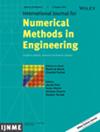A Novel Petrov-Galerkin 4-Node Quadrilateral Element With Radial Polynomial Interpolation for Linear Elastic Analysis
Abstract
Based on the virtual work principle, a novel Petrov-Galerkin 4-node quadrilateral element is proposed in this article with different sets of test and trial functions. The virtual displacements are assumed by standard isoparametric interpolation which satisfies the interelement continuity requirement. It also ensures that the imposition of prescribed displacement boundary conditions and the calculation of equivalent nodal forces are the same as the conventional isoparametric elements. A support domain is formed for each element and all nodes within it are used to interpolate the actual displacements through the radial and polynomial basis functions. The nodal shape functions obtained by the radial polynomial interpolation possess the Kronecker delta property and sufficient completeness order for convergence. The resulted element stiffness matrix is unsymmetric, generally nonsquare, due to the Petrov-Galerkin formulation. However, the global unsymmetric stiffness matrix is square, sparse and structurally symmetric. Moreover, the determinant of the Jacobian matrix can be removed from the element stiffness matrix and this improves the immunity of the numerical accuracy to mesh distortion significantly. Numerical investigations demonstrate that the present element effectively combines the advantages of both finite element methods and radial basis meshless methods. Especially, the stress continuity and interelement smoothness are improved remarkedly.

 求助内容:
求助内容: 应助结果提醒方式:
应助结果提醒方式:


